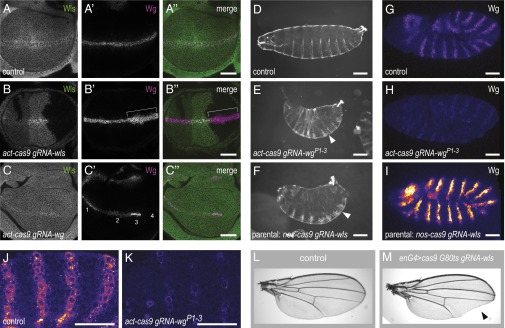Fig. 5.

Revealing mutant phenotypes through efficient biallelic targeting with transgenic CRISPR/Cas. (A–C) Genetic mosaics induced in third-instar wing imaginal discs by somatic CRISPR/Cas. (A) Control act-cas9 U6:3-gRNA-e wing discs have ubiquitous expression of Wls and expression of Wg in a stripe along the dorsal–ventral boundary. (B) act-cas9 U6:3-gRNA-wls discs have patches of cells with wild-type Wls levels, partially reduced Wls expression, and no detectable Wls protein. Wg protein accumulates intracellularly in Wg-producing cells in the absence of Wls (bracket). (C) Clones with different distributions of endogenous Wg protein can be observed in act-cas9 U6:3-gRNA-wg discs: 1, wild type; 2, nuclear accumulation; 3, increased Wg levels; and 4, no Wg protein. A second example with abnormal nuclear Wg staining is shown at higher magnification in Fig. S6. Images are representative of >10 discs of each genotype. (D–K) Biallelic targeting by transgenic CRISPR/Cas can reveal mutant phenotypes during embryogenesis. (D–F) Cuticle preparations at the end of embryogenesis. (D) act-cas9 U6:3-gRNA-e control animal. (E and F) All act-cas9 gRNA-wgP1–3 embryos (E) and most embryos from nos-cas9 U6:3-gRNA-wls parents (F) have naked region of cuticle replaced by denticle bands (exemplified by arrowheads). (G–K) Analysis of Wg protein in stage 9/10 embryos by immunostaining (“fire” lookup table facilitates comparison of Wg signal intensity in different genotypes). Compared with control nos-cas9 U6:3-gRNA-e embryos (G), Wg signal is strongly reduced in act-cas9 gRNA-wgP1–3 embryos (H) and is strongly increased in embryos from nos-cas9 U6:3-gRNA-wls parents (I). (J and K) Higher-magnification views of Wg protein in embryos, showing variation in levels in act-cas9 gRNA-wgP1–3 embryos (K), presumably caused by independent CRISPR/Cas targeting events in subsets of cells. act-cas9 U6:3-gRNA-e is shown as a control (J). Images are representative of >50 embryos examined. (L and M) Cas9 activity can be focused on specific tissues by Gal4/UAS. Expression of gRNA-wls together with UAS-cas9 (line CFD5 in Table S1) under the control of enGal4 and Gal80ts gives rise to viable flies that have wing notches posteriorly in the adult wing (M; arrowhead). Control wing (L) is from an animal that did not inherit the gRNA-wls transgene. All genotypes in this figure refer to one copy of each transgene. (Scale bars: A–C, 40 μm; D–F, 100 μm; G–K, 30 μm.)
